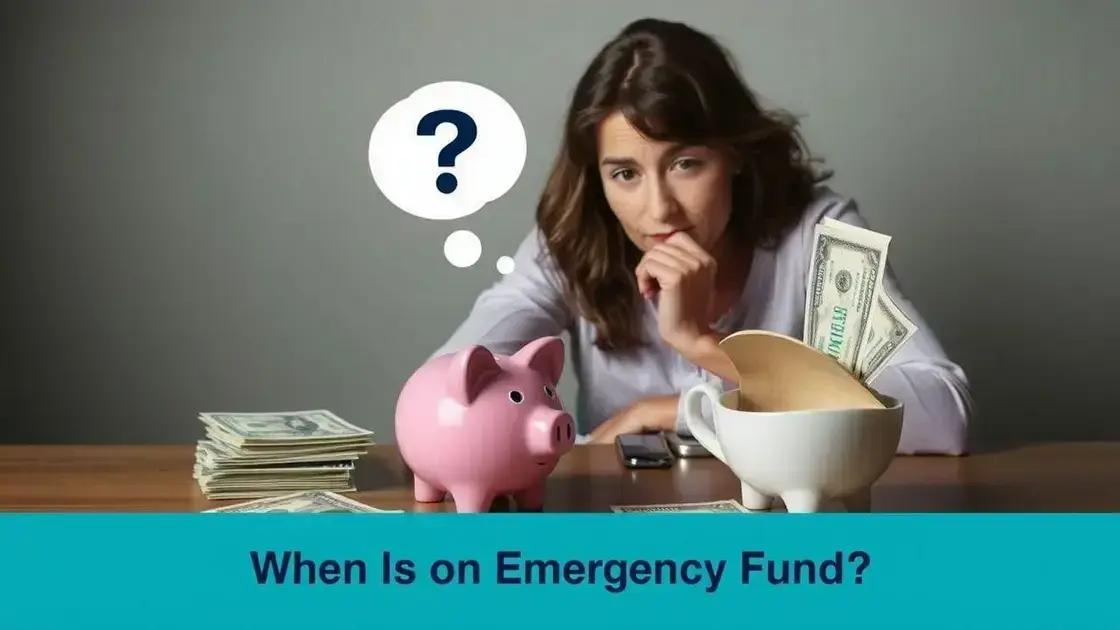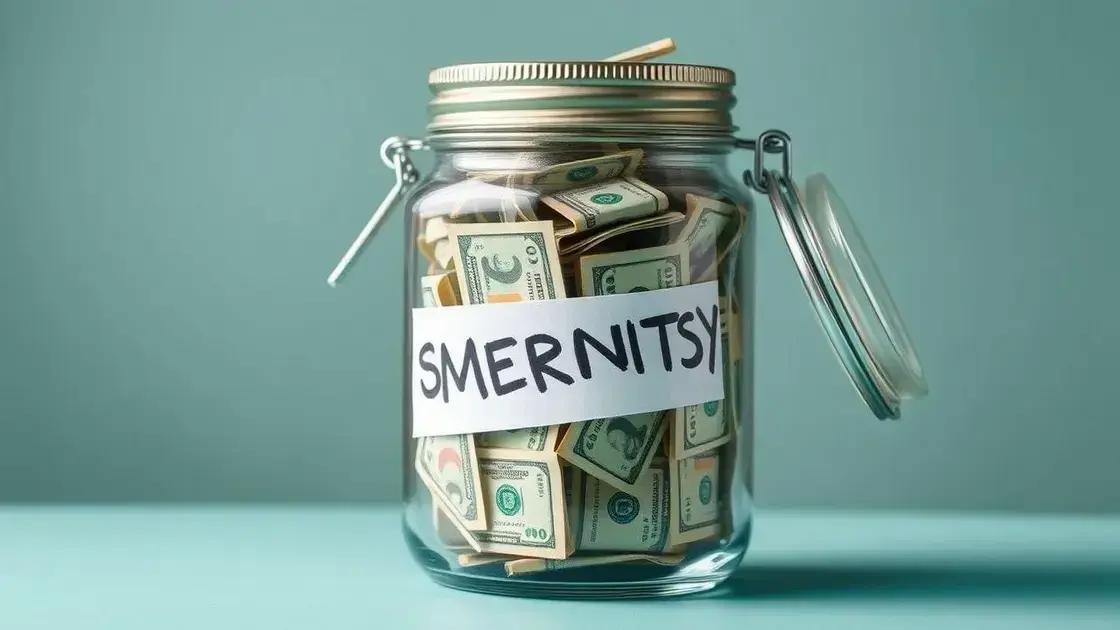Emergency fund: your safety net for unexpected situations

Anúncios
An emergency fund is a savings account earmarked for unexpected expenses like medical emergencies, home repairs, or job loss, ideally containing three to six months of living expenses for financial security.
Emergency fund plays a crucial role in financial stability, don’t you think? Having a dedicated amount set aside for unexpected expenses can save you from stress in tough times, like sudden job loss or medical emergencies. Let’s dive into why this safety net is so important.
Anúncios
Understanding what an emergency fund is
To effectively manage your finances, it’s essential to understand what an emergency fund is. An emergency fund serves as a financial safety net designed to cover unplanned expenses. This could mean anything from sudden car repairs to unexpected medical bills. The main idea behind having an emergency fund is to ensure you don’t have to rely on credit cards or loans during tough times.
What is an Emergency Fund?
An emergency fund is a savings account specifically set aside for emergencies. It’s not meant for everyday expenditures or planned purchases. Instead, it acts as a buffer for financial surprises.
Anúncios
Why is it Important?
Having an emergency fund can provide peace of mind. Here’s why:
- It reduces financial stress during unexpected situations.
- It prevents you from going into debt.
- It helps you make better financial decisions.
Consider this: when you have an emergency fund, you won’t be caught off guard by sudden costs. Instead of worrying about how to pay for a new tire or an unplanned medical visit, you can simply cover these expenses with your savings.
Also, how much should you have in your emergency fund? Financial experts recommend saving at least three to six months’ worth of living expenses. This amount allows for a comfortable buffer, ensuring you’re prepared for most situations.
Why an emergency fund is essential
Understanding why an emergency fund is essential can significantly enhance your financial security. An emergency fund acts as a financial cushion, helping you navigate unexpected expenses without derailing your budget.
Protection Against Unforeseen Costs
One of the biggest reasons to have an emergency fund is to protect yourself from unforeseen costs. Without this safety net, you might struggle to cover:
- Medical emergencies that require immediate attention.
- Unexpected car repairs that could lead to larger costs.
- Surprise home repairs that can affect your living conditions.
When these situations arise, having an emergency fund means you can respond quickly and effectively, without panicking about your finances.
Reduces Financial Stress
Additionally, a well-funded emergency fund can reduce financial stress. Knowing you have savings set aside allows for peace of mind. You won’t constantly worry about how to pay for unexpected expenses, which can improve your overall mental health.
Just think about it: if you suddenly face a large bill, not having to scramble for money can alleviate anxiety. Instead, you can focus on resolving the issue at hand.
Having an emergency fund is also about creating a safety net for your future. Financial stability is a goal for everyone, and being prepared for emergencies is a significant step toward achieving it. Regularly contributing to your fund not only helps you prepare but also builds good financial habits.
How much should you save in your emergency fund?
Determining how much you should save in your emergency fund is a crucial step in securing your financial future. The amount varies depending on individual circumstances but generally falls within a common range.
General Guidelines
Most financial experts recommend saving between three to six months’ worth of living expenses. This amount provides a solid cushion for unexpected events, enabling you to cover essentials during emergencies. Here are a few points to consider:
- Calculate your monthly expenses to determine your target.
- Consider your job stability when estimating how much to save.
- Take into account any potential future expenses.
For instance, if your monthly expenses amount to $2,000, aim for an emergency fund of $6,000 to $12,000. This range will help you feel secure, especially if you lose your income suddenly.
Personal Factors to Consider
While the three to six-month guideline is helpful, it’s essential to assess your personal situation. Some factors may require you to adjust your savings goal:
- Your job security: If you work in a volatile industry, you may want to save more.
- Family obligations: Supporting children or elderly parents may need more funds.
- Your health: Anticipate medical expenses that could arise unexpectedly.
After considering these factors, you might feel comfortable saving more than six months’ worth of expenses. The key is to ensure that your emergency fund is sufficient to cover your specific needs.
Regularly reviewing your emergency fund is also vital. As your expenses change, adjust your savings goal accordingly. This practice ensures that you remain prepared for life’s surprises while maintaining your financial health.
Where to keep your emergency fund?

Deciding where to keep your emergency fund is just as important as how much you save. The right savings location can help you access your funds quickly when needed while also earning some interest.
High-Yield Savings Accounts
A high-yield savings account is often a top choice for keeping your emergency fund. These accounts typically offer better interest rates than traditional savings accounts. Here are some reasons to consider them:
- Higher interest rates help your savings grow faster.
- Funds are easily accessible in case of emergencies.
- Many accounts are FDIC-insured, which means your money is safe.
By keeping your emergency fund in a high-yield account, you can earn a little extra money while still being prepared for unexpected expenses.
Money Market Accounts
Another option is a money market account. These accounts offer a higher interest rate than regular savings accounts and typically come with check-writing privileges. This means you can access your funds easily when an emergency arises. Consider these points:
- You may need a higher minimum balance to open them.
- Interest rates are often competitive with high-yield savings accounts.
- Funds are usually FDIC-insured as well.
Having your emergency fund in a money market account allows flexibility and quick access to your savings when you need them most.
Certificate of Deposit (CD)
While not as liquid as other options, a certificate of deposit (CD) can be another choice for some emergency funds. CDs usually offer higher interest rates in exchange for keeping your money locked in for a set term. However, make sure you only use this option for funds you can afford to be less accessible. Key points include:
- Higher interest rates than standard savings accounts.
- Punitive withdrawal fees if accessed before maturity.
- Good for those who can plan their emergencies ahead of time.
Ultimately, choosing where to keep your emergency fund depends on your comfort level and financial goals. Whether you opt for a high-yield savings account, a money market account, or even a CD, the key is to ensure that your savings are secure and accessible.
Steps to start building your emergency fund
Building your emergency fund is a vital step toward achieving financial security. It can feel overwhelming, but breaking it down into manageable steps makes it easier.
Assess Your Financial Situation
Start by taking a close look at your finances. Understanding where your money goes each month will help you determine how much you can allocate to your emergency fund. Here’s how:
- Track your monthly income and expenses.
- Identify areas where you can cut back.
- Look for extra funds from side hustles or bonuses.
By assessing your financial situation, you’ll uncover potential savings that can contribute to your emergency fund.
Set a Savings Goal
Next, set a specific savings goal. Knowing how much you want to save makes the process clearer. Start with a manageable target, such as $1,000, and then aim for three to six months’ worth of expenses. Remember:
- A clear goal keeps you motivated.
- Adjust your target as your financial situation changes.
- Celebrate small milestones along the way.
Setting a goal gives you a clear path to follow, making the task less daunting.
Create a Budget
Once you know how much you want to save, create a budget that includes contributions to your emergency fund. Here are some tips:
- Allocate a percentage of your income each month.
- Consider automating transfers to your savings account.
- Review your budget regularly to stay on track.
Having a budget helps you prioritize your savings and makes it easier to contribute consistently to your emergency fund.
Start Saving Regularly
Saving might mean making sacrifices, like cutting unnecessary expenses. It is essential to be consistent. Even small amounts can add up over time. Each paycheck, transfer a set amount into your emergency fund. Consistency is key!
This approach builds the habit of saving and increases your fund steadily. It may take time, but progress will happen!
Review and Adjust
As your finances change, regularly review your emergency fund. Your goals and financial situations can shift, so it’s essential to adjust your savings habits accordingly. Make sure you:
- Increase contributions if you receive a raise.
- Reassess your target based on life changes.
- Stay adaptable to reach your goals more effectively.
Building an emergency fund is a journey, and with these steps, you can make steady progress toward financial peace.
Common mistakes to avoid with your emergency fund
Avoiding common mistakes while managing your emergency fund is crucial to ensure its effectiveness. Understanding these pitfalls can save you from financial stress in the long run.
Using Your Emergency Fund for Non-Emergencies
One major mistake people make is dipping into their emergency fund for non-emergency expenses. It’s important to remember that this fund is for unexpected situations only. Ask yourself:
- Is this a planned expense?
- Can this wait without causing stress?
- Are there alternatives to funding this cost?
By reserving these funds specifically for true emergencies, you maintain the purpose of your emergency fund.
Not Having Enough Saved
Another mistake is under-saving. Many people don’t put away enough money in their emergency fund. Aim to save three to six months’ worth of living expenses. Here are signs you might not have enough:
- Feeling anxious about unexpected expenses.
- Having to rely on credit cards for emergencies.
- Struggling to cover basic bills during tough times.
Regularly reassess your financial situation to ensure your emergency fund is sufficient to cover your unique needs.
Failing to Replenish After Use
A common oversight is failing to replenish your emergency fund after using it. If you ever tap into this fund, make it a priority to refill it. Here are steps to consider:
- Create a plan to add extra savings after a withdrawal.
- Adjust your budget to accommodate replenishing your fund.
- Avoid viewing your fund as a permanent resource.
By actively replenishing your fund, you prepare yourself for future unforeseen expenses.
Ignoring Interest Rates and Inflation
Many people neglect to consider where they keep their emergency fund. Placing it in low-interest accounts can reduce its value over time due to inflation. To avoid this mistake:
- Choose a high-yield savings account that offers better interest rates.
- Consider using a money market account for more flexibility.
- Stay informed about accounts that can help grow your savings.
Finding the right place to keep your emergency fund helps increase its value and effectiveness.
Being aware of these common mistakes can ensure your emergency fund serves its purpose effectively, keeping you financially secure when unexpected events occur.
How to grow your emergency fund over time
Growing your emergency fund over time is essential for ensuring you have sufficient savings for unexpected events. There are several practical strategies you can adopt to help increase your fund steadily.
Make Regular Contributions
One of the simplest ways to grow your emergency fund is to make regular contributions. Setting up automatic transfers can significantly simplify this process. Consider these tips:
- Choose a specific amount to transfer each month.
- Set transfers to occur right after payday to prioritize savings.
- Increase the amount whenever you receive a raise or bonus.
Consistent contributions create a habit, allowing your fund to grow without much effort.
Consider Increasing Your Savings Rate
As your income grows, think about increasing the percentage of your income directed to your emergency fund. Here’s how:
- Review your monthly budget regularly to find extra funds.
- Look for expenses you can reduce to free up more money.
- Consider earning extra income through side jobs or freelance work.
Increasing your savings rate helps to boost your emergency fund much faster, preparing you for any unforeseen circumstances.
Take Advantage of Interest
Choosing the right account for your emergency fund can also make a difference in its growth. A high-yield savings account or money market account typically offers better interest rates compared to standard accounts. Consider:
- Comparing interest rates among different banks.
- Switching your funds to accounts that offer higher rates.
- Making sure your funds are also accessible for emergencies.
Taking advantage of interest rates can grow your savings without additional effort.
Reevaluate Your Goals Regularly
Every few months, reassess your financial goals to ensure they align with your savings plan for your emergency fund. Life changes, and so do your needs. With this in mind:
- Adjust your savings goals if your circumstances change.
- Factor in any new expenses or income sources.
- Stay committed to achieving your financial goals.
Reevaluating your goals maintains clarity in your savings journey and ensures that your emergency fund continues to grow effectively over time.
When to use your emergency fund

Knowing when to use your emergency fund is crucial for maintaining financial stability. This fund is intended for true emergencies, not for casual expenses or impulse purchases.
Understanding True Emergencies
True emergencies are situations that require immediate financial attention and cannot be planned for. Here are some situations where using your emergency fund is appropriate:
- Unexpected medical expenses, such as emergency room visits or surgeries.
- Major car repairs needed to keep your vehicle roadworthy.
- Home repairs due to sudden damage, like a leaking roof or plumbing issues.
Using your fund for these types of situations can help you avoid additional debt or financial strain.
Loss of Income
Another valid reason to tap into your emergency fund is a significant loss of income, such as job loss or reduced working hours. In such scenarios:
- Use your fund to cover monthly bills and essential living expenses.
- Keep track of your spending to extend your fund as long as possible.
- Use your emergency fund until you find new income sources or jobs.
Withdrawing from your fund during these times can help you avoid accumulating high-interest debt.
Budgeting for Unexpected Expenses
Sometimes emergencies arise that disrupt your budget unexpectedly. If you must make a significant purchase, such as replacing a broken appliance, and do not have the money saved, using your emergency fund might be warranted. Here are some steps to consider:
- Evaluate whether the expense is essential and unavoidable.
- Determine if you can adjust your budget or find other funding sources.
- Plan to replenish your fund as soon as you can.
This ensures that you can address pressing costs without sacrificing your financial well-being.
Avoiding Non-Emergency Use
It’s essential to resist using your emergency fund for non-emergencies. Discerning between a true emergency and a regular expense can be challenging. Ask yourself:
- Is this expense necessary right now?
- Can I plan for this cost in my regular budget?
- Will it significantly affect my financial stability if I do not address it immediately?
Staying mindful of these distinctions can help protect your emergency fund for when you truly need it.
FAQ – Frequently Asked Questions About Emergency Funds
What is an emergency fund?
An emergency fund is a savings account specifically set aside for unexpected expenses like medical emergencies, car repairs, or job loss.
How much should I have in my emergency fund?
Financial experts recommend saving three to six months’ worth of living expenses to ensure you are prepared for emergencies.
When should I use my emergency fund?
You should use your emergency fund for true emergencies only, such as unexpected medical bills or necessary home repairs.
How can I grow my emergency fund over time?
You can grow your emergency fund by making regular contributions, choosing high-yield savings accounts, and adjusting your savings goals as needed.






